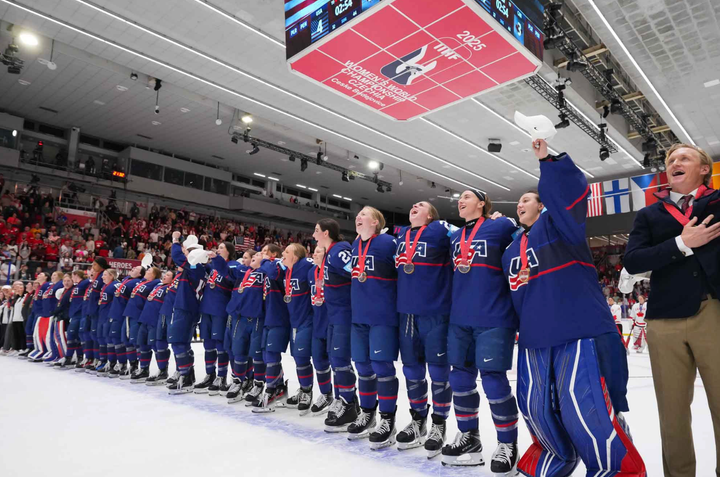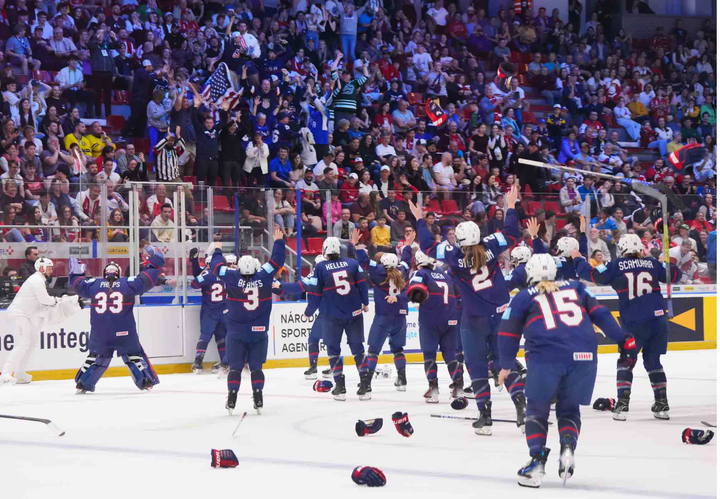Wicked Angles: what “getting uncomfortable” means in the PHF
Welcome to Wicked Angles, a column where I take a peek at all things PHF and tangentially related — on and off the ice. Opinions are unfiltered, unaffiliated, and unapologetic. Read responsibly.
It’s been an interesting few weeks in hockey, and the PHF has been no exception to that rule. With a new name, a new inclusion policy, and a new commitment to being bigger than ever before, it’s time to see this league also be better than it’s been in previous years.
The PHF recently took the “Get Uncomfortable” pledge with Black Girl Hockey Club, a campaign meant to disrupt the culture of racism within hockey at all levels. So with that kind of pledge surely comes a certain degree of commitment... but we haven’t seen or heard a whole lot since the season started. In fact, we’ve seen more about what the league seems to think is appropriate association and what it doesn’t feel responsible for than what it’s doing to change its line of thinking.
So, what does “getting uncomfortable” actually mean for hockey in general, and in a professional hockey league, specifically?
Having tough conversations with problematic individuals.
It’s not enough just to say you don’t condone someone’s behavior, beliefs, or words. Without any kind of follow-up, those declarations ring hollow, and I think we’re far past the point of understanding that saying bad things about minority groups is wrong.
So, it’s important to have those discussions with the people who need them the most, and make them understand the impact and reflect on their previous actions or statements. Maybe it’s them honestly being raised not knowing any better. Maybe it’s an intent/impact situation, where they never considered that to be an issue. Or maybe it is a deeper-rooted problem with the mindset — in which case, if they’re not willing to change at the root, then you might need to consider if they have a place in your organization after all. (More on that in a moment.)
Assuming responsibility for the actions of all, not the actions of one.
We’ve seen multiple examples now within the PHF and elsewhere of prominent league faces (and voices) saying they can’t control someone else’s actions, whom they associate with, or what they identify with. And that’s all obviously true; however, that does not absolve you from getting to the root of the problem and explaining to that person what that problem does to the people around them. A captain, a general manager, a coach, and a commissioner all have an obligation to set the example and establish the lead in more than one respect. That means in the locker room, they have to be just as vocal about bad behavior as they are about a bad check or an errant pass.
Anyone in your league, cashing your checks, and wearing your jersey, is representative of YOU as a brand. As such, they and you both have a responsibility that is much bigger and far beyond you as an individual. Anyone who doesn’t understand that, or who doesn’t necessarily feel inclined to share that responsibility, shouldn’t wear a letter or have that kind of pull within the league. If a league pledges to be “for everyone,” or wants to “get uncomfortable,” they need to stand by that. Otherwise, why even bother unless it’s for good PR?
Putting together plans of action for addressing cultural or systemic issues within the league.
There is nuance to everything. A bad action, or even an association with bad actors, doesn’t necessarily mean someone is beyond hope. And we’re all at a point where we know the difference between an individual’s mistake and something that needs to be brought out from under the surface. We’ve all seen the severe shortcomings when it comes to pinning decades’ worth of abuse, bigotry, or any other ill on one person or even a group of people. It’s easy to think you’ve accomplished a lot by getting rid of the one tumor, but when it’s metastasized, more work needs to be done, and quickly.
So it’s important not to get caught up in focusing on one person, one team, even one league. The issues facing hockey today — those of misogyny, hypermasculinity, homophobia, racism — all of those are painted right into the ice these players skate on. It isn’t enough just to cover it up and hope it doesn’t bleed through; no, we need to scrape down to the base and start anew.
Bringing in marginalized voices and addressing the intersections of those marginalizations to provide expertise where your own is insufficient.
No one knows everything. I don’t know what it’s like to be a Black woman or a trans individual. I’m not about to act like I do. If I want to address anti-Black racism in hockey, I’m sure as hell not going to do it myself — no, I’m going to get a Black person to do it for me. There’s clearly a balance in this and we need to remember the importance of not treating marginalized folk as our living Wikis, but at the same time, the answer to that is not taking it all on ourselves.
So yes — include those voices, not as a token or for one day or one month. Include them always, at every conversation, at every table. No one puts away their race, gender, orientation, or creed when they put on their hockey skates. Those angles should always be considered, and if you’ve never thought of them, that’s an area of opportunity for you to grow.
Proper apologies — not necessarily PR apologies.
Mess-ups happen. Yes, we’re all human. Yes, we are all learning and growing. Yes. We. All. Know. This. We don’t think you’re a robot or that you are never going to change. After all, we all started from somewhere and we all participate in the same shitty society. So enough of those disclaimers that sound like nothing but a way to dodge responsibility faster than an Autumn MacDougall breakaway. We’re not going to absolve you for the curse of “humanity.” That era is over and done with.
Public relations is such an important tool when it comes to those with this kind of platform, and as someone who’s studied journalism and PR, I get that there are standards and specifics when it comes to the language of a press release or an apology. But those standards were also created at a much, much different time — one that didn’t have the Notes app or a greater desire for honesty than for theatrics. We need to evolve those standards, and we need to approach every mistake sincerely, without excuses or waffling or passive voice.
The worst kind of “apology” is one that stops shy of admittance and veers toward copping out. Own your actions. Own your words. Own yourself.
Taking action when necessary to make examples of bad behavior, regardless of someone’s name, position, stature, or skill level.
Just like personal accountability, organizational accountability is paramount. It comes back to the idea that anyone with your crest on their chest has your brand at risk. Anyone at any level must be held responsible by the league if they’re a part of it. No amount of hand-waving or finger-pointing will change that, so you can put away your Spider-Man costume.
Also, it doesn’t matter how talented someone is or how many likes they get on the team Tiktok — if they don’t have the right principles, it should be an issue. Your star player should have the same level of integrity as the newest rookie on the squad. End of story. If you’re more concerned about the on-ice product, or you’re too scared to stand up to a star, then what are we doing here? And what are these “values” of which you speak when it comes to what hockey can do for the individual?
**************************************************
It’s tough. It’s difficult. It’s uncomfortable. That’s the point.
We can’t look at any other sport, or even outside of sport in general, without taking a good, hard look at how the sport of hockey enables bigotry and lets it fester under the guise of “team-first mentality.” It’s time we ditched that tired ass phrase and embraced accountability — TRUE accountability, in every form and sense of the word.
Let’s actually start squirming, y’all.





Comments ()